Abstract
The development of more electric aircrafts (MEA) and all electric aircrafts (AEA) inevitably implies an increase in electric power and a consequent increase in distribution voltage levels. Increased operating voltages coupled with low pressure in some areas of the aircraft greatly increase the chances of premature insulation failure. Insulation failure manifests itself as surface discharges, arc tracking, arcing, and disruptive or breakdown discharges, in order of increasing severity. Unfortunately, on-board electrical protections cannot detect discharges at an early stage, so other strategies must be explored. In their early stage, insulation faults manifest as surface and corona discharges. They generate optical radiation, mainly in the near-ultraviolet (UV) and visible spectral regions. This paper focuses on a method to detect the discharges, locate the discharge sites, and determine their intensity to facilitate predictive maintenance tasks. It is shown that by using small size and low-cost image sensors, it is possible to detect, locate, and quantify the intensity of the discharges. This paper also proposes and evaluates the behavior of a discharge severity indicator, which is based on determining the intensity of digital images of the discharges, so it can be useful to apply predictive maintenance tasks. The behavior and accuracy of this indicator has been tested in the laboratory using a low-pressure chamber operating in the pressure range of 10–100 kPa, which is characteristic of aircraft applications, analyzing a needle-plane air gap geometry and using an image sensor. The proposed method can be extended to other applications where electrical discharges are an issue.
1. Introduction
The strict administrative regulations related to the reduction of CO2 equivalent emissions are pushing the aeronautical sector to develop new generations of aircraft with less environmental impact, greater efficiency, lower fuel consumption, or easier maintenance than their predecessors. In this sense, the aircraft industry is developing alternatives, such as the more electric aircraft (MEA) and all electric aircraft (AEA), which, due to demanding requirements in terms of electric power, require operation at higher distribution voltage levels [1], mainly to limit the weight of cabling systems. It is well known that increased voltage levels produce higher electric stress in electric and electronic components and in insulation materials. According to various sources, future aircraft models could operate at higher voltages, in the range from 1 kV [2] up to 4.5 kV [3], which, added to the extreme environmental conditions and high compactness ratios typical of aircraft applications, generate severe electric stress on insulation systems. The higher electric stress increases the intensity and the risk of occurrence of different types of discharges [4], such as surface discharges, arc tracking, arcing, and finally disruptive discharges, which produce different effects, including acoustic and electromagnetic emissions, ultraviolet (UV) and visible light emissions, induction of current pulses in electric circuits, different chemical reactions, or heating, among others. The intensity of the corona spectral bands is known to increase with supply voltage [5]. The persistent effect of the discharges in insulation materials induces chemical changes resulting from the flow of electrons at the discharge locations [6], increasing their temperature, thus progressively degrading insulation systems, which in turn favors discharge occurrence and eventually leads to major failures [7].
Partial discharges (PDs) occur between two electrodes insulated by a solid, liquid, or gaseous insulation when the local electric field strength exceeds the dielectric strength of the insulation material. PDs do not entirely bridge the insulation path between the electrodes [8]. In the case of gaseous insulation, they are known as corona, which are localized and luminous discharges that occur near an electrode, triggered by a highly inhomogeneous electric field [9] that exceeds a critical value [10,11]. Contrarily, disruptive discharges completely bridge the insulation path between two electrodes [8]. In non-uniform air gaps, corona appears at a lower voltage than the one required to produce a disruptive discharge [12]. In the case of uniform electric fields in air, disruptive discharges appear without previous corona activity.
Although in the short term persistent PDs do not usually pose a serious threat to polymeric insulation in cabling systems, in the long term, due to continuous chemical changes, because of the flow and bombardment of released electrons [6], they can cause serious damage. The chemical changes eventually create a conductive track in the polymeric insulation, which favors the flow of an electric current, thus raising the temperature in the track and causing further damage in the insulation. This sustained situation weakens the insulation and promotes arcing activity [13], which appears in the insulation between wires due to the formation of a carbonized track. Further discharges spread existing tracking paths, generating the arc tracking phenomenon [7], thus extending the damage and eventually causing a fire hazard [14].
Cruising altitudes of commercial jetliners are in the range of 10–13 km, while some other aircrafts have altitude ceilings greater than 15 km, so that operating pressure can be reduced to 10% of the sea level value. It is well known that in atmospheric air, the minimum voltage level at which discharges appear decreases with pressure [15,16], so electric and electronic circuits placed in unpressurized aircraft areas are more susceptible to incidence of electrical discharges [17,18] compared to sea level conditions [19]. It is known that surface degradation of polymeric samples increases as pressure decreases because discharge activity accelerates at lower pressure [20].
For safety and maintenance reasons, and due to strict regulations, the risk of electrical discharges in airplanes must be minimized. Commercial widebody jetliners have complex harnesses, hundreds of kilometers of wires, and thousands of wiring components, such as connectors, clamps, or terminations. Most of these components are hidden inside conduits, ducts, or troughs [21], so maintenance and failure detection tasks become difficult to apply. Due to their low intensity, electrical discharges go unnoticed by the on-board electrical protections, especially at an early phase. However, their persistent effect degrades insulation materials [22], eventually leading to major failures [23]. Therefore, combined actions, such as an improved design and a plan to monitor the discharges, are required to minimize the severity and occurrence of failures. Monitored data enables application of predictive maintenance actions [18] while increasing aircraft safety and allowing application of remedial strategies before critical faults develop [24].
Wiring systems are critical elements for the occurrence of discharges [7], which are often placed in environments with high levels of acoustic and electromagnetic noise, where conventional acoustic or electromagnetic systems to detect partial discharges would fail. It is in these applications where optical sensors are attractive due to their high immunity to electromagnetic and acoustic noise. Optical sensors detect the light produced during the discharge process [25] due to the different transitions of excitation, ionization, and recombination of electrons induced by the discharge [26]. In the case of using optical image sensors, it is also possible to locate and quantify the severity of the discharges, as proposed in this paper, since it is essential for the reliable, safe, and stable operation of aircraft power systems [27]. This approach makes it possible to study the temporal evolution of discharges, thus opening the possibility of developing state of health (SoH) and remaining useful life (RUL) methods, which are the basis for applying predictive maintenance plans. This field requires more research and experimental data because there is very little experimental work using image sensors for SoH and RUL applications in insulation systems. By analyzing the temporal evolution of the discharges, SoH and RUL tools could provide key information so that remedial actions can be taken before major failures are triggered.
Image sensors are increasingly used to detect corona discharges. In [28], the damage caused by corona discharges to polymeric insulating samples was located and analyzed by means of digital photographs, while in [29,30], the damage caused by mist and acidic fog to polymeric samples exposed to corona discharges was evaluated by means of digital images. In [31], it was revealed that the intensity of the discharges is correlated with the number of photons generated. Using a different approach, in [27], it was shown that under direct current (dc) supply, the electric power dissipated by the PDs is related to the energy of the digital images of the discharges. In [32], the luminosity content of digital images of alternating current (ac) corona discharges was studied and correlated with the measured electric power due to discharge activity. However, [32] lacks a precise analysis, which is required due to the complexity of the electric signals of the discharges, especially due to their low intensity, short duration, and high-frequency content.
This paper contributes in different ways to the area of electrical discharges under ac supply at low pressure, in the range of 10–100 kPa, which is representative of aeronautical applications. First, the magnitude of the fault is measured by applying two approaches, and it is proved that they are directly related. On the one hand, the electric energy dissipated by electric discharges is calculated by means of electric measurements and suitable data processing. On the other hand, the photographs of the discharges are acquired with a digital camera, and their intensity is determined after suitable processing of the digital images. Next, it is shown that the electric energy dissipated by the discharges and the intensity of the digital images are directly related. Finally, a simple and quick to calculate discharge severity indicator is defined based on the intensity of the discharges detected by the image sensor, since it is a key element to quantify the magnitude of the fault, a novelty in this field, which can be very useful for applying predictive maintenance strategies. Although this paper focuses on the aeronautical sector, the results presented may also be interesting in other areas where electrical discharges are a problem, such as plasma surface treatments or to monitor power lines and cables installed at high altitude.
The rest of the article is organized as follows. Section 2 details the signal processing methods applied to determine the electric energy dissipated by electrical discharges and the intensity of discharges in digital images. Section 3 introduces the discharge severity indicator. Section 4 details the experimental setup required to perform the experiments. Section 5 presents the experimental data obtained in a low-pressure chamber and discusses the results obtained. Finally, Section 6 concludes the document.
2. Applied Signal Processing Techniques
This section describes the methods proposed in this paper to determine the electric energy dissipated by the discharges and the intensity of the discharges from the digital images provided by a complementary metal oxide semiconductor (CMOS) image sensor. In a practical application, it is not necessary to determine the electric energy associated with the discharges, but here it is done to verify that it is directly related to the intensity of the digital images of the discharges.
2.1. Electric Energy Dissipated by the Electrical Discharges
The average or active power of a circuit is defined as the average value of the instantaneous power, which in discrete form can be expressed as [32]
where v(k) and i(k) are, respectively, the instantaneous values of the voltage and the current in the circuit, kΔt is the instant of time in which the instantaneous power is calculated, and Δt is the time step of the experimental acquisitions of voltage and current.
Although (1) is easy to apply, some considerations are required due to the high-frequency components and the short duration of the discharges. First, the discharges appear in different points in the waveform, initially appearing during the negative semi period of the voltage, and as the voltage increases, they also appear during the positive semi period. It means that each discharge has its own voltage, which is not constant during the duration of the discharge. Second, due to their low level, it is easier to distinguish the discharges in the current waveform than in the voltage waveform, as seen in Figure 1.
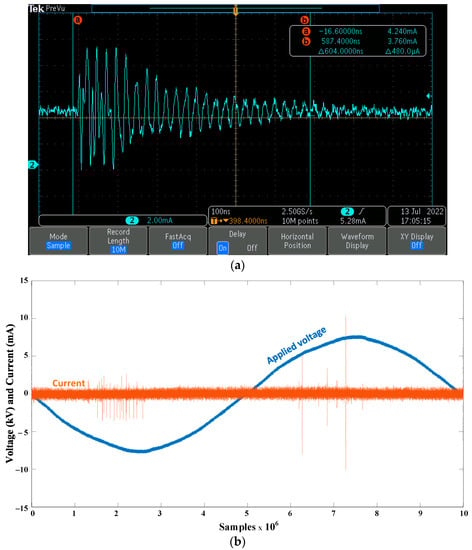
Figure 1.
(a) Current profile of a discharge acquired with an oscilloscope. (b) Current and voltage profiles during a period of the voltage waveform acquired at a rate of 107 samples per period of the supply voltage.
To determine the energy of the discharges, the following strategy was applied, which is also summarized in Figure 2:
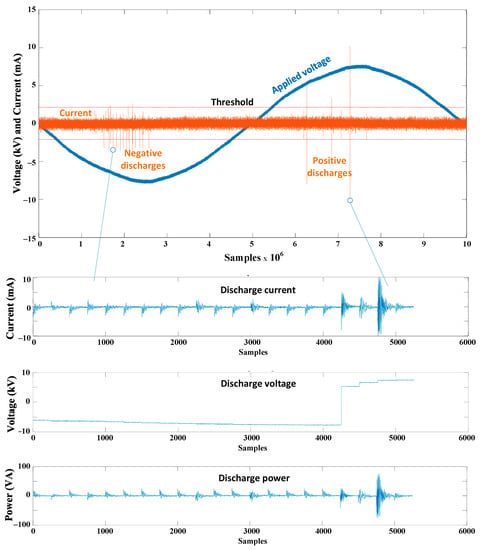
Figure 2.
Applied data processing strategy to determine the energy dissipated by the discharges.
- Synchronous acquisition of the voltage and the current over a period of the voltage waveform.
- Apply a threshold to the acquired current to determine whether or not a discharge occurs and select a window of N points (N = 200 points in this work, although it depends on the resolution of the image sensor and the geometry of the problem) around the threshold value, as shown in Figure 2.
- Apply the same window to the acquired voltage. All windows must have the same number of points.
- Calculate the average power of each discharge by applying (1).
- The electric energy dissipated by the discharges in one cycle of the applied voltage is calculated as:where Pdischarge(j) is the power of the j-th discharge calculated from (1) and N is the number of data points in each considered window (number of points considered in each discharge).
2.2. Intensity of the Digital Images
Current image sensors acquire digital images, Im×n, in the form of a matrix of m × n pixels. Each pixel is designated as I(i,j), where (i,j) defines the position in the matrix, with 1 ≤ i ≤ m, 1 ≤ j ≤ n [33]. The image Im×n has a resolution of P = m × n pixels.
All pixels in RGB images contain a triplet (R,G,B) that defines the color coordinates in the RGB colour space, where R = red, G = green, and B = blue, so each pixel is defined by a (1,3) vector. The image results in
where IRGB(i,j,k) is represented by 8-bit unsigned integers, and since 28 = 256, 0 ≤ IRGB(i,j,k) ≤ 255.
To determine the intensity of the images, it is common to transform the original RGB image into a grayscale image using the following transformation [34]:
where the weights 0.299, 0.587, and 0.114 of the red, green, and blue channels, respectively, are taken considering the luminous efficacy function of the average human eye, thus approaching the average spectral sensitivity of the human eye.
Once the RGB images have been transformed into grayscale images, their intensity [35,36] can be calculated as:
The digital image contains sensor and background noise. To reduce the noise effect, a window around the discharge is selected and the effect of the background noise is removed (see Figure 3):
where m∗ < m and n∗ < n are the vertical and horizontal dimensions of the selected window and Bgrayscale(i,j) is the 8-bit unsigned value of the i-th j-th position of the background. Equation (6) assumes that in the grayscale image, the value of each pixel (in the 0–255 range) is proportional to the amplitude of the incident light integrated over the exposure time and the pixel area. Since the energy of a wave is proportional to the square of its amplitude, in this paper, it is assumed that the square root of the energy dissipated by the discharges calculated from (2) is proportional to the intensity of the images calculated from (6). Section 5 assesses the accuracy of this approach by means of experimental data.
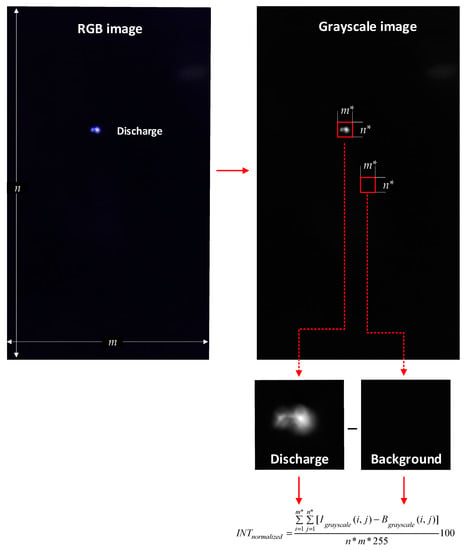
Figure 3.
Summary of the image processing to determine the intensity of the discharges from digital RGB images.
Figure 3 summarizes the procedure applied to determine the intensity of the discharges calculated from the digital images.
Finally, (6) is normalized to return values within the range 0 to 100,
3. Discharge Severity Indicator
The severity of the discharge is related to the intensity or magnitude of the fault [37]. In this paper, it is assumed that the magnitude of the fault can be estimated by using a suitable discharge severity indicator. If it can be verified experimentally that the intensity of the images is directly related to the electric energy dissipated by the discharges, the intensity of the digital images could itself be a simple and fast to calculate severity indicator. Therefore, this paper proposes to use (8) as a discharge severity indicator, which, from (6) and (7), can be expressed as:
The adequacy of this approach is assessed in more detail in Section 5.2.
According to (8), the values of the discharge severity indicator INTnormalized, which are related to the intensity of the discharge, must be within the 0–100 interval, where low values of INTnormalized indicate a healthy state without discharges, while high values indicate saturation of the analyzed pixels and thus a high severity of the fault. Section 5.3 presents a detailed analysis of the threshold values to consider.
4. Experimental
In this paper, discharges of different intensity or magnitude are generated by increasing the voltage applied to a needle-plane air gap configuration. To emulate pressure conditions in aircraft systems, the discharges are generated inside a low-pressure chamber in the pressure range of 10–100 kPa at 20 °C.
The stainless-steel low-pressure chamber consists of a 375 mm × 260 mm (height × diameter) cylindrical vessel and a methacrylate lid that allows the photographs to be wirelessly transmitted to a computer located near the chamber. The chamber is grounded during the experiments. The low-pressure chamber contains the smartphone used to take the long exposure photographs and the needle-plane gap, as shown in Figure 4.
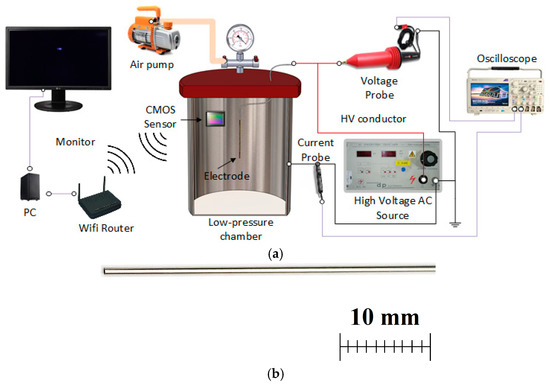
Figure 4.
(a) Sketch of the experimental setup used to reduce the pressure and generate electric discharges. (b) Needle-plane air gap (stainless steel, diameter = 0.8 mm).
The pressure inside the chamber was changed using a vacuum pump (BA-1, 1/4 HP, 85 L/min, Bacoeng, Suzhou, China). The ac voltage was changed by means of an adjustable ac high-voltage source (TecnolabRD6, 0–14.4 kVpeak, 600 VA, dp Electronica SL, Barcelona, Spain).
The applied voltage and leakage current were acquired synchronously using a high-performance oscilloscope (MDO3024, 200 MHz, 2.5 Msamples/s, Tektronix, Beaverton, OR, USA). A high-voltage probe (CT4028, 0–39 kVpeak, reduction ratio 1000:1, accuracy < 3%, dc to 220 MHz, Electronics, Yorba Linda, CA, USA) was used to adapt the high voltage to the requirements of the oscilloscope. The leakage current circulating through the ground conductor (see Figure 4) was measured using a Hall effect current probe (TCP0030A, dc to >120 MHz, accuracy 1 mA, Tektronix, Beaverton, OR, USA), which was placed around the ground wire to detect the current of the discharges travelling from the high-voltage electrode to the ground terminal.
It is well known that discharges emit near-UV and visible light. In this work, they were acquired by means of a high-resolution back-illuminated CMOS imaging sensor (sensor size 8.0 mm, cell size 0.8 μm × 0.8 μm, 48 Mpixels, lens focal 17.9 mm, raw format images, IMX586, Sony, Tokyo, Japan). This type of sensor was used because it is known to be sensitive to both visible and UV radiation [38,39]. A computer connected to a Wi-Fi router wirelessly controlled the CMOS image sensor, so images could be taken from inside the chamber while it was pressurized. Due to the low intensity of the discharges, to improve the sensitivity of the images, the camera was operated in the long exposure mode (exposure time of 32 s, ISO 800, manual focus).
Corona discharges were generated using a needle-plane air gap, because this geometry is one of the reference gaps used in high-voltage applications [40]. It consists of a 0.8 mm diameter cylindrical stainless-steel needle with a 70 mm long air gap.
5. Experimental Results
This section presents and discusses the experimental results obtained in the low-pressure chamber using the instrumentation and air gap geometry described in Section 4.
5.1. Digital Images of the Discharges
Long exposure photographs of the discharges (32 s) were taken to increase the number of photons reaching the sensitive elements of the image sensors and thus the sensitivity of the method. Figure 5 summarizes some of the photographs of the discharges acquired under different experimental conditions, that is, under variable pressures within the range of 100–10 kPa and different applied voltages. It is seen that, for a fixed pressure, the intensity of the discharge increases with the applied voltage.
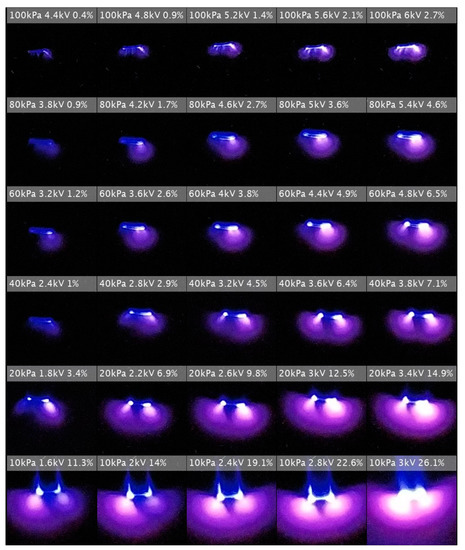
Figure 5.
Long exposure photographs of the discharges under the experimental conditions described in the images (voltages expressed in RMS value). The images indicate the operating pressure, the applied voltage, and the value of the discharge severity indicator INTnormalized.
From the photographs shown in Figure 5, it is deduced that the intensity of the images of the discharges increases with the applied voltage, that is, with the electric energy dissipated by the discharges. However, this correlation must be validated using experimental data acquired with the voltage and current probes and by calculating the intensity of the discharges acquired by the CMOS image sensor.
5.2. Relationship between the Intensity of the Images and the Electric Energy Dissipated by the Discharges
This section shows that the electric energy dissipated by the discharges is related to the intensity of the digital images. The relationship between the intensity of the images and the electric energy dissipated by the discharges assumed and evaluated in this section is as follows:
The adequacy of (9) is assessed in the next paragraphs. According to (9), the square root of the energy dissipated by the discharges must be proportional to the normalized intensity of the images. It is based on the fact that the amplitude of the signal detected by any individual sensitive element of the CMOS sensor is directly related to the intensity of the light spreading over the sensor. In addition, INTnormalized can be used as a discharge severity indicator, providing values from 0 to 100, indicating the degree of severity.
Figure 6a summarizes the experimental relationships between INTnormalized and the applied voltage, while Figure 6b shows the experimental measurements obtained with the photometric (INTnormalized) and electric (Edischarges0.5) methods and their linear fittings at different operating pressures characteristic of aeronautical environments.
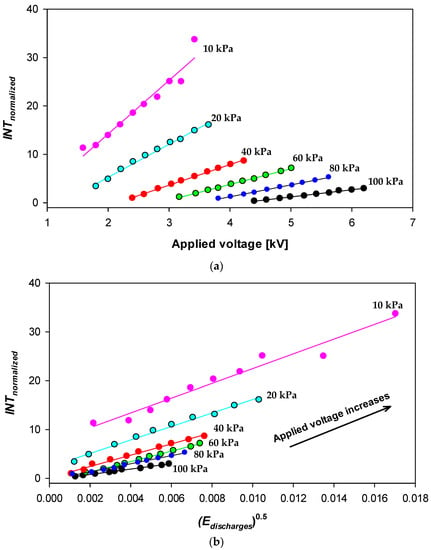
Figure 6.
Experimental results. (a) Correlations between the normalized intensity of the digital images of the discharges and the applied voltage. (b) Correlations between the normalized intensity of the digital images of the discharges and the square root of the electric energy dissipated by the discharges.
The experimental results presented in Figure 6a show a linear behavior between INTnormalized and the applied voltage. Since the intensity of the discharges increases with the applied voltage, these results show that INTnormalized is related to the severity of the discharges.
The results presented in Figure 6b show a linear behavior between INTnormalized and Edischarges0.5, thus validating the hypothesis expressed in (9). Table 1 summarizes the parameters of the linear fittings between INTnormalized and Edischarges0.5, where high values of the coefficient of determination R2 can be seen, thus indicating a high correlation between INTnormalized and Edischarges0.5. Therefore, it can be concluded that the electric energy dissipated by the discharges is proportional to the intensity of the digital images.

Table 1.
Main parameters of the linear regression between INTnormalized and Edischarges0.5 (INTnormalized = INTo + k· Edischarge0.5).
Results summarized in Figure 6 and Table 1 clearly show the strong linearity between the normalized intensity of the discharge images INTnormalized and the square root of the electric energy dissipated by the discharges Edischarges0.5. These results confirm that INTnormalized can be used as an indicator of the discharge severity.
5.3. Criterion to Determine the Severity of the Discharges
Results presented in Section 5.2 show that INTnormalized can be used as a discharge severity indicator.
Disruptive discharges were then performed to determine the upper limit of the INTnormalized indicator. The results obtained indicate that under the experimental conditions of this work, in case of disruptive discharges, the severity indicator INTnormalized,upper is always greater than 50, so an upper threshold value of this indicator can be established as INTnormalized,upper = 50.
Finally, the lower limit of the INTnormalized indicator was tested. Without the presence of electric discharges, due to the noise of the CMOS sensor and the background, the value indicated by the INTnormalized indicator is not zero. Tests indicate that under our experimental conditions, this value is less than 0.1, so a threshold lower value INTnormalized,lower = 0.1 of this indicator can be established.
Results obtained manifest that INTnormalized can be applied as a discharge severity indicator, as follows:
- When (INTnormalized ≤ INTnormalized,lower), it corresponds to a healthy condition, without discharges.
- When (INTnormalized,lower < INTnormalized < INTnormalized,upper), it corresponds to a fault condition, where discharges occur. In this case, a higher value of INTnormalized corresponds to a higher discharge severity.
- When (INTnormalized ≥ INTnormalized,upper), it corresponds to the worst fault condition, that is, a disruptive discharge.
Therefore, a continuous monitoring of the discharges using a digital camera with additional processing to determine the INTnormalized discharge severity indicator allows detection of anomalous conditions and generating an alert, which can be very useful to apply predictive maintenance strategies.
6. Conclusions
The low-pressure environments, characteristic of aeronautical applications, favor the inception of electrical discharges in electric and electronic circuits placed in unpressurized areas. However, in their early state, due to the low energy level involved, they are undetected by on-board protections until a major failure develops. This paper has developed an optical method to detect, locate, and quantify the severity of the discharges at the earliest stage. The proposed method is based on detecting the near-UV and visible light emitted by the discharges using a high-resolution and low-cost image sensor. A discharge severity indicator based on the intensity of digital images of the discharges has been proposed and tested, demonstrating its accuracy and ability to quantify the magnitude of the discharges in all phases, from the early stage to the development of disruptive discharges. The behavior of the method and fault indicator proposed in this paper has been validated through experimental data acquired in a low-pressure chamber at different pressures in the range of 10–100 kPa, characteristic of aircraft applications, using a needle-plane air gap geometry and a high-resolution low-cost image sensor. Finally, a criterion for quantifying the magnitude of the discharges based on the discharge severity indicator has been proposed, which allows detecting and quantifying of anomalous conditions, which can be very useful to apply predictive maintenance strategies. The results presented in this work allow the fault to be detected at an early stage, long before irreversible damage occurs, so they can complement the on-board electrical protections, which are currently triggered when the fault is well developed. Further work will include testing the approach proposed in this paper in wire bundles to identify and quantify surface discharges and arc tracking activity at a very early stage. Although the method proposed in this paper has been tested in a simulated aircraft environment, a similar approach can be implemented in other applications where electrical discharges are an issue.
Author Contributions
Conceptualization, P.B.-C. and J.-R.R.; methodology, J.-R.R.; software, J.-R.R., P.B.-C. and B.O.; validation, P.B.-C., B.O., Y.A.Q. and M.P.; formal analysis, J.-R.R.; investigation, P.B.-C. and J.-R.R.; resources, J.-R.R.; writing—original draft preparation, P.B.-C. and J.-R.R.; writing—review and editing, J.-R.R.; supervision, B.O., Y.A.Q. and M.P. All authors have read and agreed to the published version of the manuscript.
Funding
This research was funded by Ministerio de Ciencia e Innovación de España, grant number PID2020-114240RB-I00, and by the Generalitat de Catalunya, grant number 2017 SGR 967.
Institutional Review Board Statement
Not applicable.
Informed Consent Statement
Not applicable.
Data Availability Statement
Not applicable.
Conflicts of Interest
The authors declare no conflict of interest.
References
- Riba, J.-R.; Gómez-Pau, Á.; Moreno-Eguilaz, M. Experimental Study of Visual Corona under Aeronautic Pressure Conditions Using Low-Cost Imaging Sensors. Sensors 2020, 20, 411. [Google Scholar] [CrossRef]
- Mermigkas, A.C.; Clark, D.; Manu Haddad, A. Investigation of High Altitude/Tropospheric Correction Factors for Electric Aircraft Applications. In Lecture Notes in Electrical Engineering; Springer: Berlin/Heidelberg, Germany, 2020; Volume 598, pp. 308–315. [Google Scholar]
- Clean Sky. Annex V: 9th Call for Proposals (CFP09)—List and Full Description of Topics; European Commission: Brussels, Belgium, 2018; pp. 1–354. [Google Scholar]
- FAA. Aircraft Electrical Wiring Interconnect System (EWIS) Best Practices; FAA: Washington, DC, USA, 2020. [Google Scholar]
- Maistry, N. Investigating the concept of Fraunhofer lines as a potential method to detect corona in the wavelength region 338 nm–405 nm during the day. In Proceedings of the 19th International Symposium on High Voltage Engineering, Pilsen, Czech Republic, 23–28 August 2015; pp. 1–61. [Google Scholar]
- Du, B.X.; Liu, Y.; Liu, H.J. Effects of low pressure on tracking failure of printed circuit boards. IEEE Trans. Dielectr. Electr. Insul. 2008, 15, 1379–1384. [Google Scholar] [CrossRef]
- Riba, J.-R.; Gómez-Pau, Á.; Moreno-Eguilaz, M.; Bogarra, S. Arc Tracking Control in Insulation Systems for Aeronautic Applications: Challenges, Opportunities, and Research Needs. Sensors 2020, 20, 1654. [Google Scholar] [CrossRef] [PubMed]
- The Authoritative Dictionary of IEEE Standards Terms (IEEE 100), 7th ed.; IEEE: Piscataway, NJ, USA, 2000; pp. 1–1362.
- Borghei, M.; Ghassemi, M. Separation and Classification of Corona Discharges under Low Pressures Based on Deep Learning Method. IEEE Trans. Dielectr. Electr. Insul. 2022, 29, 319–326. [Google Scholar] [CrossRef]
- Rudd, S.; McArthur, S.D.J.; Judd, M.D. A generic knowledge-based approach to the analysis of partial discharge data. IEEE Trans. Dielectr. Electr. Insul. 2010, 17, 149–156. [Google Scholar] [CrossRef]
- Yi, Y.; Zhang, C.; Wang, L. Time-domain performance of audible noise for positive dc corona: Numerical simulations and measurements. IEEE Trans. Dielectr. Electr. Insul. 2016, 23, 3275–3282. [Google Scholar] [CrossRef]
- Anis, H.; Srivastava, K.D. Pre-breakdown Discharges in Highly Non-uniform Fields in Relation to Gas-insulated Systems. IEEE Trans. Electr. Insul. 1982, EI-17, 131–142. [Google Scholar] [CrossRef]
- Cella, B. On-Line Partial Discharges Detection in Conversion Systems Used in Aeronautics. Ph.D. Thesis, Université de Toulouse, Toulouse, France, 2015. [Google Scholar]
- Meng, D.; Zhang, B.Y.; Chen, J.; Lee, S.C.; Lim, J.Y. Tracking and erosion properties evaluation of polymeric insulating materials. In Proceedings of the ICHVE 2016—2016 IEEE International Conference on High Voltage Engineering and Application, Chengdu, China, 19–22 September 2016; IEEE: Piscataway, NJ, USA, 2016. [Google Scholar]
- Riba, J.-R.; Moreno-Eguilaz, M.; Ibrayemov, T.; Boizieau, M. Surface Discharges Performance of ETFE- and PTFE-Insulated Wires for Aircraft Applications. Materials 2022, 15, 1677. [Google Scholar] [CrossRef]
- Paschen, F. Ueber die zum Funkenübergang in Luft, Wasserstoff und Kohlensäure bei verschiedenen Drucken erforderliche Potentialdifferenz. Ann. Phys. 1889, 273, 69–96. [Google Scholar] [CrossRef]
- Esfahani, A.N.; Shahabi, S.; Stone, G.; Kordi, B. Investigation of Corona Partial Discharge Characteristics Under Variable Frequency and Air Pressure. In Proceedings of the 2018 IEEE Electrical Insulation Conference (EIC), San Antonio, TX, USA, 17–20 June 2018; IEEE: Piscataway, NJ, USA, 2018; pp. 31–34. [Google Scholar]
- Capineri, L.; Dainelli, G.; Materassi, M.; Dunn, B.D. Partial discharge testing of solder fillets on PCBs in a partial vacuum: New experimental results. IEEE Trans. Electron. Packag. Manuf. 2003, 26, 294–304. [Google Scholar] [CrossRef] [Green Version]
- Rui, R.; Cotton, I. Impact of low pressure aerospace environment on machine winding insulation. In Proceedings of the 2010 IEEE International Symposium on Electrical Insulation, San Diego, CA, USA, 6–9 June 2010; IEEE: Piscataway, NJ, USA, 2010; pp. 1–5. [Google Scholar]
- Banerjee, S.; Shakthi Prasad, D. AC Corona Degradation of Silicone Rubber Nanocomposites at Low Air Pressure. IEEE Trans. Dielectr. Electr. Insul. 2022, 29, 800–807. [Google Scholar] [CrossRef]
- Bas-Calopa, P.; Riba, J.R.; Moreno-Eguilaz, M. Corona Discharge Characteristics under Variable Frequency and Pressure Environments. Sensors 2021, 21, 6676. [Google Scholar] [CrossRef] [PubMed]
- Zhang, L. Electrical Tracking over Solid Insulating Materials for Aerospace Applications. Ph.D. Thesis, University of Manchester, Manchester, UK, 2011. [Google Scholar]
- Riba, J.-R.; Gomez-Pau, A.; Moreno-Eguilaz, M. Sensor Comparison for Corona Discharge Detection under Low Pressure Conditions. IEEE Sens. J. 2020, 20, 11698–11706. [Google Scholar] [CrossRef]
- Xavier, G.V.R.; Da Costa, E.G.; Serres, A.J.R.; Nobrega, L.A.M.M.; Oliveira, A.C.; Sousa, H.F.S. Design and Application of a Circular Printed Monopole Antenna in Partial Discharge Detection. IEEE Sens. J. 2019, 19, 3718–3725. [Google Scholar] [CrossRef]
- Xu, Y.; Yu, M.; Cao, X.; Qiu, C.; Chen, G. Comparison between optical and electrical methods for partial discharge measurement. In Proceedings of the 6th International Conference on Properties and Applications of Dielectric Materials, Xi’an, China, 21–26 June 2000; Volume 1, pp. 300–303. [Google Scholar]
- Burjupati, N.R.; Puhan, D.K.; Sharma, R. Opto Electronic Technique for Detection of Corona Discharges in Air and Oil. In Proceedings of the 2019 IEEE Electrical Insulation Conference (EIC), Calgary, AB, Canada, 16–19 June 2019; pp. 184–187. [Google Scholar]
- Riba, J.-R.; Gómez-Pau, Á.; Moreno-Eguilaz, M. Insulation Failure Quantification Based on the Energy of Digital Images Using Low-Cost Imaging Sensors. Sensors 2020, 20, 7219. [Google Scholar] [CrossRef]
- Prasad, D.S.; Reddy, B.S. Image Saturation as a Tool to Understand the Corona Induced Degradation of Polymeric Insulators. IEEE Trans. Dielectr. Electr. Insul. 2020, 27, 1837–1844. [Google Scholar] [CrossRef]
- Shakthi Prasad, D.; Subba Reddy, B. Impact of mist and acidic fog on polymer insulator samples exposed to corona discharges. IEEE Trans. Dielectr. Electr. Insul. 2016, 23, 1546–1554. [Google Scholar] [CrossRef]
- Prasad, D.S.; Reddy, B.S. Study on Corona Activity Using an Image Processing Approach. IEEE Trans. Ind. Appl. 2017, 53, 4008–4014. [Google Scholar] [CrossRef]
- Pinnangudi, B.; Gorur, R.S.S.; Kroese, A.J.J. Quantification of corona discharges on nonceramic insulators. IEEE Trans. Dielectr. Electr. Insul. 2005, 12, 513–523. [Google Scholar] [CrossRef]
- Prasad, D.S.; Reddy, B.S. Digital image processing techniques for estimating power released from the corona discharges. IEEE Trans. Dielectr. Electr. Insul. 2017, 24, 75–82. [Google Scholar] [CrossRef]
- Sastry, S.S.; Mallika, K.; Rao, B.G.S.; Tiong, H.S.; Lakshminarayana, S. Identification of phase transition temperatures by statistical image analysis. Liq. Cryst. 2012, 39, 695–700. [Google Scholar] [CrossRef]
- Padmavathi, K.; Thangadurai, K. Implementation of RGB and Grayscale Images in Plant Leaves Disease Detection—Comparative Study. Indian J. Sci. Technol. 2016, 9, 1–6. [Google Scholar] [CrossRef]
- González, R.C.; Woods, R.E. Digital Image Processing, 3rd ed.; Pearson Prentice Hall: Upper Saddle River, NJ, USA, 2008; ISBN 978-0-13-168728-8. [Google Scholar]
- Prasad, D.S.; Reddy, B.S. Understanding Corona Discharges using Digital Imaging. In Proceedings of the 2018 IEEE International Conference on High Voltage Engineering and Application (ICHVE), Athens, Greece, 10–13 September 2018; IEEE: Piscataway, NJ, USA, 2018; pp. 1–4. [Google Scholar]
- Cerrada, M.; Sánchez, R.V.; Li, C.; Pacheco, F.; Cabrera, D.; Valente de Oliveira, J.; Vásquez, R.E. A review on data-driven fault severity assessment in rolling bearings. Mech. Syst. Signal Process. 2018, 99, 169–196. [Google Scholar] [CrossRef]
- Turner, J.; Igoe, D.; Parisi, A.V.; McGonigle, A.J.; Amar, A.; Wainwright, L. A review on the ability of smartphones to detect ultraviolet (UV) radiation and their potential to be used in UV research and for public education purposes. Sci. Total Environ. 2020, 706, 135873. [Google Scholar] [CrossRef]
- Wu, H.; Wang, J.; Liu, P.; Peng, Z.; Deng, Z.; Wei, X. Research on corona inception electric-field strength and critical electric-field values for valve hall fittings. In Proceedings of the 2014 IEEE Conference on Electrical Insulation and Dielectric Phenomena (CEIDP), Des Moines, IA, USA, 19–22 October 2014; pp. 308–311. [Google Scholar]
- He, Z.; Zhu, J.; Zhu, J.; Bian, X.; Shen, B. Experiments and analysis of corona inception voltage under combined AC-DC voltages at various air pressure and humidity in rod to plane electrodes. CSEE J. Power Energy Syst. 2021, 7, 875–888. [Google Scholar]
Publisher’s Note: MDPI stays neutral with regard to jurisdictional claims in published maps and institutional affiliations. |
© 2022 by the authors. Licensee MDPI, Basel, Switzerland. This article is an open access article distributed under the terms and conditions of the Creative Commons Attribution (CC BY) license (https://creativecommons.org/licenses/by/4.0/).